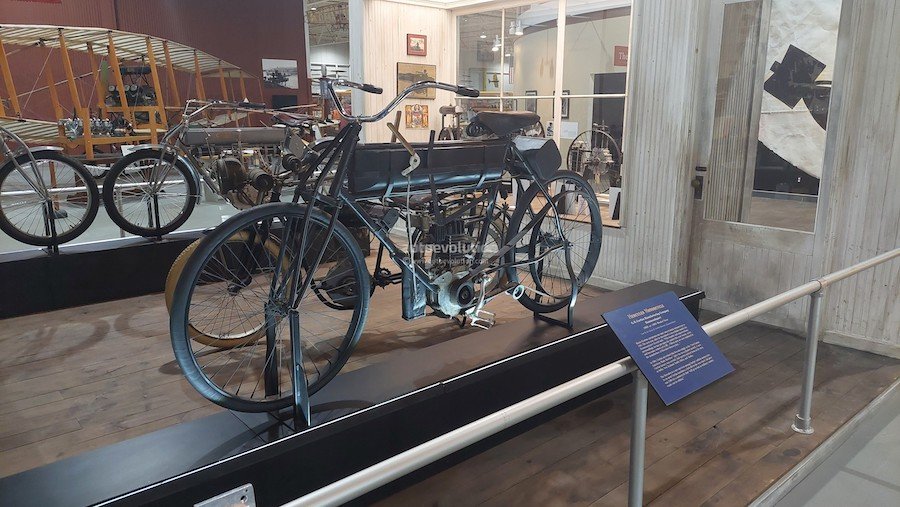Forget Harley and Indian, Curtiss Built the Coolest Antique American Motorcycles

But none of those folks alive today were around in a time before this was the case. A time before those two monikers solidified themselves as the only two American motorcycle brands worth talking about. In the early 1900's everything was fair game. If you're an eccentric, top-notch inventor nearly without parallel, this was your time to claim your stake in a burgeoning field of motorized bicycles. Luckily, Glenn H Curtiss was that type of genius.
As a youth, Hammondsport, New York's favorite native son, was a feverous tinkerer. A skill that led him down the path of fabricating his own bicycles from scratch. By the late 1890s, Curtiss ran three different retail bicycle stores and repair shops in the Finger Lakes region of Central New York.
By contemporary accounts, he was also a remarkably skilled bicycle racer. But as the staff at the Glenn H Curtiss Museum in Hammondsport will tell you, the American entire automotive industry, not just motorcycles, changed
forever. By the museum's own accounts, the carburetor on Curtiss's very first motorbike engine was fashioned from a soup can.
Rest assured, his designs wouldn't be that archaic for long. By 1903, he was using a single-cylinder two-stroke engine to travel 65 miles an hour using a modified bicycle chassis. At the time, this was arguably the fastest motor vehicle in the world, the fastest one not on rails, at the very least.
But those who know the story of Glenn Curtiss know he was a man whose appetite for speed couldn't be satisfied in his time. So he simply decided to make the world around him faster, all powered by his own top-notch internal combustion engines.
Another notable footnote from this period in Curtiss's life was a visit to Hammondsport by an executive from the parent company of Indian Motorcycles, Hendee Manufacturing Company. During his trip, the executive by the name of Mr. E.H Corson was astonished to find Glenn Curtiss had shoved his entire motorcycle manufacturing operation into one tiny shed connected via a door to the showroom floor of his bike shop.
It was all the more shocking because that previous weekend, Corson's motorcycles proceeded to have their collective" you know what's" handed to them on a silver plater by Glenn Curtiss himself on a single-cylinder racing bike that'd been built in this tiny room.
But because Curtiss was a little bit of a mad scientist in his day, in the best and nicest terms possible, he decided the only way forward was to double the number of cylinders. At least, in theory, doubling the power and speed as well. In 1909, a full two calendar years before Harley-Davidson, Curtiss unveiled his first V-Twin engine.
There's a bit of debate as to whether Indians did or didn't beat Curtiss to the title of first American V-twin motorbike engine. Some peg Indian's V-twin debut as early as 1904 in prototype form and generally agreed to be around 1907.
But regardless of whose side you take in that affair, one can't help but root for Curtiss in the whole business. Especially considering how much he contributed to the formative years of the art form and how his tragic passing at just 52 all but doomed his company to a merger in the end.
In any case, Curtiss was still not done innovating by the early 1910s, not even close. Apart from dipping his feet in aviation for the first time, thanks to help from Alexander Graham Bell of all people through the Aerial Experiment Association Bell himself founded.
Soon thereafter, Curtiss was ready to unveil a racing bike unlike any the world had yet seen. Here are the quick stats, eight cylinders in two banks of four, 269 cubic inches in (4.4 liters) of displacement, with four stoke-capability instead of two.
It was an engine as technologically advanced in its day as the recond holding version of Kawasaki Ninja's is in 2022, the HR2. No wonder it was originally meant to power an airplane. While we're on the subject of the world's fastest modern hyperbike, let's conclude today's expose into Curtiss motorcycles by the numbers.
With a confirmed top speed of 357 kph (221 mph) kph in the 2022 Kawasaki Ninja HR2, The Curtiss V8 motorcycle maxed out with a top speed of 218 kph (137). It was over 60% of the way to today's modern world record for street legal motorcycles all the way back in 1908. A time before every American home had indoor plumbing or electricity.
No wonder soon after the V8 motorbike, Glenn Curtiss sunsetted his motorcycle endeavors in order to devote his time to becoming a global pioneer of aviation. Why? Because the more speed you attain, it's only a matter of time before you start flying.
If you didn't know, he was just as good, if not better, with planes than he was with bikes. What a guy, there simply aren't any other words. That's the kind of person he was and why this fantastic museum exists at all, and why so many people work to preserve his legacy.
Noticias relacionadas
